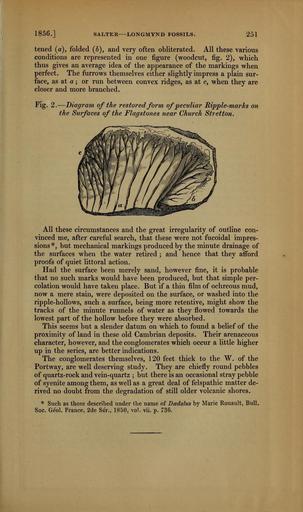MAKE A MEME
View Large Image

| View Original: | The_Quarterly_journal_of_the_Geological_Society_of_London_(12683336893).jpg (1247x2106) | |||
| Download: | Original | Medium | Small | Thumb |
| Courtesy of: | commons.wikimedia.org | More Like This | ||
| Keywords: The Quarterly journal of the Geological Society of London (12683336893).jpg 1856 <br> SALTER LONGMYND FOSSILS <br> 251 <br> tened a folded 6 and very often obliterated All these various <br> conditions are represented in one figure woodcut fig 2 which <br> thus gives an average idea of the appearance of the markings when <br> perfect The furrows themselves either slightly impress a plain sur- <br> face as at a ; or run between convex ridges as at c when they are <br> closer and more branched <br> Fig 2 � Diagram of the restored form of peculiar Ripple-marks on <br> the Surfaces of the Flagstones near Church Stretton <br> All these circumstances and the great irregularity of outline con- <br> vinced me after careful search that these were not fucoidal impres- <br> sions but mechanical markings produced by the minute drainage of <br> the surfaces when the water retired ; and hence that they afford <br> proofs of quiet littoral action <br> Had the surface been merely sand however fine it is probable <br> that no such marks would have been produced but that simple per- <br> colation would have taken place But if a thin film of ochreous mud <br> now a mere stain were deposited on the surface or washed into the <br> ripple-hollows such a surface being more retentive might show the <br> tracks of the minute runnels of water as they flowed towards the <br> lowest part of the hollow before they were absorbed <br> This seems but a slender datum on which to found a belief of the <br> proximity of land in these old Cambrian deposits Their arenaceous <br> character however and the conglomerates which occur a little higher <br> up in the series are better indications <br> The conglomerates themselves 120 feet thick to the W of the <br> Portway are well deserving study They are chiefly round pebbles <br> of quartz-rock and vein-quartz ; but there is an occasional stray pebble <br> of syenite among them as well as a great deal of felspathic matter de- <br> rived no doubt from the degradation of still older volcanic shores <br> Such as those described under the name of Dadalus by Marie Rouault Bull <br> See Geol France 2de Ser 1850 vol vii p 736 35338700 109655 51125 Page 251 Text v 12 http //www biodiversitylibrary org/page/35338700 1856 Geological Society of London NameFound Dadalus Biodiversity Heritage Library The Quarterly journal of the Geological Society of London v 12 1856 Geology Periodicals Smithsonian Libraries bhl page 35338700 dc identifier http //biodiversitylibrary org/page/35338700 smithsonian libraries Information field Flickr posted date ISOdate 2014-02-21 Check categories 2015 August 26 CC-BY-2 0 BioDivLibrary https //flickr com/photos/61021753 N02/12683336893 2015-08-27 11 53 50 cc-by-2 0 PD-old-70-1923 The Quarterly journal of the Geological Society of London 1856 Photos uploaded from Flickr by Fæ using a script | ||||